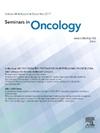Overexpression of CAD in stomach adenocarcinoma tissues and its clinical significance
IF 2.5
3区 医学
Q2 ONCOLOGY
引用次数: 0
Abstract
Stomach adenocarcinoma (STAD) is one of the deadliest malignant tumors worldwide. Carbamoyl-phosphate synthetase 2 (CAD) expression is essential for categorizing and detecting STAD initiation and development. We explored the differential expression of genes (DEGs) affected by CAD overexpression and subsequently revealed the classification module of CAD-based scoring sets using weighted gene co-expression network analysis (WGCNA). Subsequently, enrichment analysis of biological functions and signaling pathways in clinically significant modules was conducted. We constructed a CAD-based clinical scoring model using univariate and multivariate Cox regression analyses. In addition, by using immune cell infiltration analysis, we investigated the interaction between CAD-based score and the immune microenvironment, identified upstream regulatory factors, including RNA binding proteins (RBPs), that affect the transcription of the STAD-related CAD-based score, and explored potential drug targets. We identified 4,977 abnormal regulatory genes related to CAD in STAD, among which the module genes most related to CAD were significantly enriched in cancer-related signaling pathways, such as VEGF, MAPK and TGF-beta signaling pathway. The CAD-based scores, T and N were identified as independent prognostic factors for STAD patients. We also found that under the influence of high expression of CAD, the infiltration level of most immune cells is lower, such as CD4 T cells and Tfh, and CAD has an inhibitory effect on the infiltration of certain immune cells. Notably, the potential drug targets PDHB and NDUFB6 are upstream regulatory factors in STAD. This study explored the role of highly expressed CAD-related genes in STAD and explored the tumorigenesis and progression of this disease. This research identified potential diagnostic and prognostic drug targets and provided new insights into the molecular mechanisms of STAD.
CAD在胃腺癌组织中的过表达及其临床意义
胃腺癌(STAD)是世界上最致命的恶性肿瘤之一。氨甲酰磷酸合成酶2 (CAD)的表达对于STAD的发生和发展的分类和检测至关重要。我们探索了受CAD过表达影响的基因(deg)的差异表达,随后使用加权基因共表达网络分析(WGCNA)揭示了基于CAD的评分集的分类模块。随后,对临床重要模块的生物学功能和信号通路进行富集分析。我们使用单变量和多变量Cox回归分析构建了基于cad的临床评分模型。此外,通过免疫细胞浸润分析,我们研究了基于cad的评分与免疫微环境之间的相互作用,确定了上游调控因子,包括RNA结合蛋白(rbp),影响stad相关的基于cad的评分的转录,并探索了潜在的药物靶点。我们在STAD中发现了4977个与CAD相关的异常调控基因,其中与CAD最相关的模块基因在肿瘤相关信号通路中显著富集,如VEGF、MAPK和tgf - β信号通路。基于cad的评分、T和N被确定为STAD患者的独立预后因素。我们还发现,在CAD高表达的影响下,大多数免疫细胞的浸润水平降低,如CD4 T细胞和Tfh, CAD对某些免疫细胞的浸润有抑制作用。值得注意的是,潜在的药物靶点PDHB和NDUFB6是STAD的上游调控因子。本研究探讨了高表达的cad相关基因在STAD中的作用,并探讨了该疾病的肿瘤发生和进展。本研究确定了潜在的诊断和预后药物靶点,并为STAD的分子机制提供了新的见解。
本文章由计算机程序翻译,如有差异,请以英文原文为准。
求助全文
约1分钟内获得全文
求助全文
来源期刊

Seminars in oncology
医学-肿瘤学
CiteScore
6.60
自引率
0.00%
发文量
58
审稿时长
104 days
期刊介绍:
Seminars in Oncology brings you current, authoritative, and practical reviews of developments in the etiology, diagnosis and management of cancer. Each issue examines topics of clinical importance, with an emphasis on providing both the basic knowledge needed to better understand a topic as well as evidence-based opinions from leaders in the field. Seminars in Oncology also seeks to be a venue for sharing a diversity of opinions including those that might be considered "outside the box". We welcome a healthy and respectful exchange of opinions and urge you to approach us with your insights as well as suggestions of topics that you deem worthy of coverage. By helping the reader understand the basic biology and the therapy of cancer as they learn the nuances from experts, all in a journal that encourages the exchange of ideas we aim to help move the treatment of cancer forward.
 求助内容:
求助内容: 应助结果提醒方式:
应助结果提醒方式:


